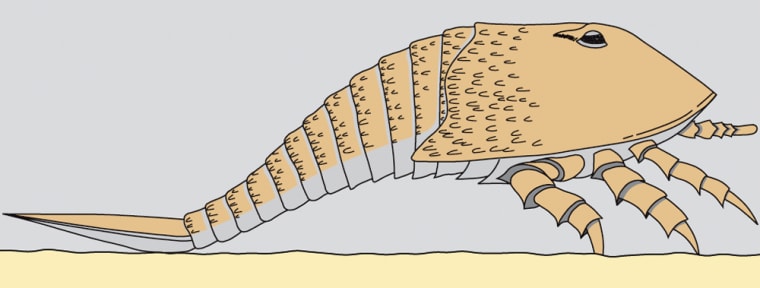Tracks found in Scotland look to be from an ancient water scorpion as big as a kitchen table. If the analysis is right, it is the first evidence of the creature coming ashore.
The scorpion, a six-legged thing called Hibbertopterus, was about 5 feet (1.5 meters) long and 3 feet (1 meter) wide. It is long since extinct.
Researchers already knew Hibbertopterus existed from fossils, but they've debated whether it ever came on land.
The tracks, found by Martin Whyte of the University of Sheffield, cover nearly 20 feet (6 meters) of ground. They reveal a lumbering, jerky motion, Whyte explains in Thursday's issue of the journal Nature.
Slow and jerky
Crescent-shape scarps were left by the outer limbs, inner markings were made by a double-keeled belly, and a central groove was carved by its tail.
"The slow, stilted progression, together with the dragging of the posterior, indicates that the animal was not buoyant and that it was probably moving out of water," Whyte says.
No other known arthropod could have left the marks, the geologist concludes. The tracks indicate that Hibbertopterus could survive out of water at least briefly, he said.
"Their gills would probably have functioned in air as long as they remained wet," Whyte told LiveScience. "However, I doubt if they would ever have been able to become fully adapted to life on land."
Scary-looking but benign
Hibbertopterus would have looked frightening if we were to go back in time and confront one, but it was not equipped to attack large animals.
"I think the animal would certainly have been fearsome in aspect whether you met it in or out of the water," Whyte said. "However, the evidence of its feeding apparatus suggests that it had two anterior limbs specialized for sweeping through water and capturing small organisms."
Hibbertopterus and its relatives were the last surviving water scorpions, all having died out about 250 million years ago.
Very distant cousins have survived to modern times, however. The closest living relatives are land scorpions, king crabs and horseshoe crabs, Whyte said. "The latter are marine animals but do penetrate far up rivers and do at times come out of water onto sandy beaches."
